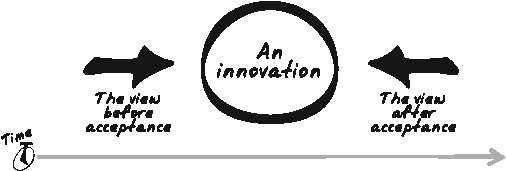Every creator hears similar criticisms to his ideas. While I don't have proof, I bet the first caveman who captured fire, the first Sumerian with a wheel, the first person to do anything interesting in any society in human history, heard one of the following after he pitched his idea:
This well never work.
No one will want this.
It can't work in practice.
People won't understand it.
This isn't a problem.
This is a problem, but no one cares.
This is a problem and people care, but it's already solved.
This is a problem, and people care, but it will never make money.
This is a solution in search of a problem.
Get out of my office/cave now.
Sometimes very smart people say these things. Ken Olsen, founder of the Digital Equipment Corporation, said in 1977, "There is no reason anyone would want a computer in their home." The leading art critics in France, in response to the opening of the Eiffel Tower, made comments like, "[that] tragic lamppost springing up from its bowelsâ¦[is] like a beacon of disaster and despair." [73] It took the British Navy, at the peak of their dominance in the 17th century, 150 years to adopt a proven remedy for scurvy. Bo Peabody, serial entrepreneur, wrote, "It's astounding the number of people who will tell you and your ideas are crazy. I have been thrown out of more than a thousand offices while building my six companies." [74] Remember, it's hard to know the future, and all great minds have failed to predict what would take off and what wouldn't. My point isn't to make fun of famous people for being wrong; instead, it's to point out that we're all wrong much of the time (see Figure 4-1).
Figure 4-1. Many critics demanded that the Eiffel Tower be torn down when it was built. Today, it's one of Paris' most popular attractions.
Experienced innovators anticipate these criticisms. They prepare refutations or preempt them, as in, "Who would want electricity in their homes? Let me tell you whoâ¦" [75] But even with preparation, charm, and amazing ideas, convincing people to see an idea in the same way as its creator is difficult. Most have little interest in having their minds changed, a fact that's hard to remember when you've spent your life savings, or an entire weekend, killing yourself to invent something. This gapâthe difference between how an innovator sees his work from how it's seen by othersâis the most frustrating challenge innovators face. Creators expect to be well received. They look at accepted innovations and the heroes who delivered them and assume their new innovations will be treated the same way (see Figure 4-2). But no matter how brilliant an idea is, the gap exists. Until the innovation is accepted, it will be questioned relentlessly.
Figure 4-2. Innovators know of other innovations only after the fact, and they are surprised when their ideas are treated differently from the accepted innovations of the past.
Many innovators give up when they learn ideas, even with dazzling prototypes or plans in hand, are the beginning. The challenges that follow demand skills of persuasion more than brilliance. As Howard Aiken, a famous inventor, said, "Don't worry about people stealing an idea. If it's original, you will have to ram it down their throats." [76] Although beating up people to convince them rarely works, Aiken's point holds: people are unlikely to be as interested in your ideas as you are.
The observation many would-be innovators never make is that most criticisms are superficial. The spoken questions only hint at the real concerns. Responding to superficial comments is a loser's game, persuading demands mapping criticisms to deeper issues. All of the negative comments listed above can be mapped to one or more of the following perspectives likely held by others:
Ego/envy: I can't accept this because I didn't think of it.
Pride and politics: This makes me look bad.
Priority: I have 10 innovative proposals but resources for one.
Sloth: I'm lazy, bored, and don't want to think or do more work. [77]
Security: I may lose something I don't want to lose.
Greed: I can make money or build an empire if I reject this idea.
Consistency: This violates my deeply held principles (no matter how absurd, outdated, or ridiculous they are).
The effect of these feelings, whether justified or irrational, is the same. They're just as real in the mind of the person feeling them as anything else. If your boss feels threatened by a proposalâeven if those reasons seem entirely paranoid or delusional to youâthose feelings will define his behavior in response to new ideas. If those feelings are strong, it's easy for him to use the comments above to reject proposals for even the greatest ideas. If the innovator defends only the superficial and makes no attempt to persuade the deeper feelings to change, or find ways to recast the innovation so that those feelings become positive, she will fail to get the support she needs.
For example, when Galileo claimed the sun was the center of the solar system, he faced persecution from the Church and the Western world for reasons listed above. It wasn't the idea itself that caused the outrageâit was how that idea made them feel. They didn't care about what was at the center of the solar system. Galileo would have been in similar trouble had he suggested the earth rotated around a purple dragon or a half-eaten sandwich. They weren't upset about the details of his theory; they were angry that anyone would advocate a theory different from the one they believed in (of course, making fun of the Pope didn't help any). [78] It was the principle of the thing and how it questioned their sense of orderâtwo common reasons for rejecting ideas that have nothing to do with the idea itself.
This is the magic double-secret principle: innovative ideas are rarely rejected on their merits; they're rejected because of how they make people feel. If you forget people's concerns and feelings when you present an innovation or neglect to understand their perspectives in your design, you're setting yourself up to fail.
[73] John Lienhard, The Engines of Our Ingenuity (Oxford University Press, 2006), 186.
[74] From Lucky or Smart, 28.
[75] Edison was a shameless promoter of electricity, crossing moral and ethical lines. He created the first electric chair to demonstrate that his competitors' designs were unsafe, unlike his (which wasn't true). Matthew Josephson, Edison: A Biography (McGraw-Hill, 1959), 348â349.
[77] Related quote: "Most people would rather die than think; in fact, they do so." âBertrand Russell
[78] In short, when Galileo wrote Dialogue Concerning the Two Chief World Systems, he put quotes from Pope Urban VIII into the mouth of his character Simplicius, a fool who is ridiculed for defending against heliocentricism. See James Reston, Galileo: A Life (Beard Books, 2000).
Get The Myths of Innovation now with the O’Reilly learning platform.
O’Reilly members experience books, live events, courses curated by job role, and more from O’Reilly and nearly 200 top publishers.



